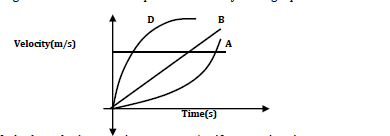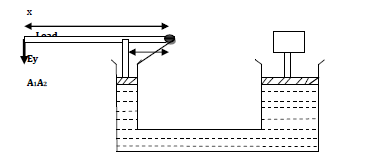A body falling freely in a vacuum starts from an initial velocity zero and accelerates at approximately 9.8ms-2 towards the centre of the earth. This is called the acceleration due to gravity g. In this case, the air resistance is assumed to be negligible. Note that in a vacuum, a feather and a stone released from the same height will take the same amount of time to reach the surface of the earth.
Therefore, in the three equations of linear motion u=0m/s, s=h and a=g. thus the three equations become:
v=gt, (from v=u+at)
h=½gt2, (from s=ut+½gt2)
v2=2gh, (from v2=u2+2as)
From the above equations:
- v= (2gh)½, where v is the velocity of the body just before it hits the ground.
- h=½gt2=v2/2g, where h is the height through which the body falls.
- t=v/g=(2h/g)½, where t is the time of flight.
sharon kalunda answered the question on April 24, 2019 at 05:44
- Using a tick-timer tape show the patterns for the following motions;
a)A body moving at constant velocity.
b)A body moving with increasing velocity (accelerating).
c)A body moving with...(Solved)
Using a tick-timer tape show the patterns for the following motions;
a)A body moving at constant velocity.
b)A body moving with increasing velocity (accelerating).
c)A body moving with decreasing velocity (decelerating).
In each case show the direction of motion.
Date posted: April 24, 2019. Answers (1)
- Describe the following Velocity-time graphs:(Solved)
Describe the following Velocity-time graphs:

Date posted: April 24, 2019. Answers (1)
- Explain the dangers of static charges(Solved)
Explain the dangers of static charges
Date posted: April 23, 2019. Answers (1)
- In the figure below x=30cm, y=6cm, effort E=60N, A1=4cm2 and A2=12cm2.(Solved)
In the figure below x=30cm, y=6cm, effort E=60N, A1=4cm2 and A2=12cm2.

Calculate:
a) The force F exerted on the liquid at A1.
b) The velocity ratio of the system.
c) The maximum load that can be raised by the system.
Date posted: April 23, 2019. Answers (1)
- A box of mass 30kg is pushed up an inclined plane of length 14m using a force of 130N as shown below:(Solved)
A box of mass 30kg is pushed up an inclined plane of length 14m using a force of 130N as shown below:

If the track is inclined at an angle of 200, calculate:
a) The height of the platform.
b) Workdone by the force of 130N.
Date posted: April 23, 2019. Answers (1)
- Draw a flow chart to show the energy transformation in a hydroelectric power station:(Solved)
Draw a flow chart to show the energy transformation in a hydroelectric power station:
Date posted: April 23, 2019. Answers (1)
- State the characteristics energy:(Solved)
State the characteristics energy:
Date posted: April 23, 2019. Answers (1)
- The mass of a density bottle is 20g when empty and 45g when full of water. When full of mercury, its mass is 360g. Calculate...(Solved)
The mass of a density bottle is 20g when empty and 45g when full of water. When full of mercury, its mass is 360g. Calculate the density of mercury.
Date posted: April 23, 2019. Answers (1)
- Derive the three equations of linear motion.(Solved)
Derive the three equations of linear motion.
Date posted: April 23, 2019. Answers (1)
- The figure below represents part of a tape pulled through a ticker-timer by a trolley moving down an inclined plane. If the frequency of the...(Solved)
The figure below represents part of a tape pulled through a ticker-timer by a trolley moving down an inclined plane. If the frequency of the ticker-timer is 50Hz, calculate the acceleration of the trolley.

Date posted: April 23, 2019. Answers (1)
- A paper tape was attached to a moving trolley and allowed to run through a ticker-timer. The figure below shows a section of the tape.(Solved)
A paper tape was attached to a moving trolley and allowed to run through a ticker-timer. The figure below shows a section of the tape.

If the frequency of the ticker-timer is 20Hz, determine:
a) The velocity between AB and CD.
b) The acceleration of the trolley.
Date posted: April 23, 2019. Answers (1)
- A body is made to change its velocity from 20m/s to 36m/s in 0.1s. What is the acceleration produced?(Solved)
A body is made to change its velocity from 20m/s to 36m/s in 0.1s. What is the acceleration produced?
Date posted: April 23, 2019. Answers (1)
- Outline the three common types of motion:(Solved)
Outline the three common types of motion:
Date posted: April 23, 2019. Answers (1)
- A machine with a velocity ratio of 30 moves a load of 300N when an effort of 200N is applied. Calculate the efficiency of the...(Solved)
A machine with a velocity ratio of 30 moves a load of 300N when an effort of 200N is applied. Calculate the efficiency of the machine.
Date posted: April 22, 2019. Answers (1)
- Explain why a man using a parachute falls through air slowly while a stone falls through air very fast(Solved)
Explain why a man using a parachute falls through air slowly while a stone falls through air very fast.
Date posted: April 22, 2019. Answers (1)
- A man makes a deeper marks while walking on a soft ground in a high heeled shoes than in a flat shoes. Explain(Solved)
A man makes a deeper marks while walking on a soft ground in a high heeled shoes than in a flat shoes. Explain
Date posted: April 22, 2019. Answers (1)
- Explain how temperature affects Brownian motion(Solved)
Explain how temperature affects Brownian motion.
Date posted: April 18, 2019. Answers (1)
- State the applications of extended light sources(Solved)
State the applications of extended light sources
Date posted: April 15, 2019. Answers (1)
- State the advantage of the Pinhole Camera over the Lens Camera(Solved)
State the advantage of the Pinhole Camera over the Lens Camera
Date posted: April 15, 2019. Answers (1)
- Discuss the Maintenance of the Accumulators(Solved)
Discuss the Maintenance of the Accumulators
Date posted: April 15, 2019. Answers (1)